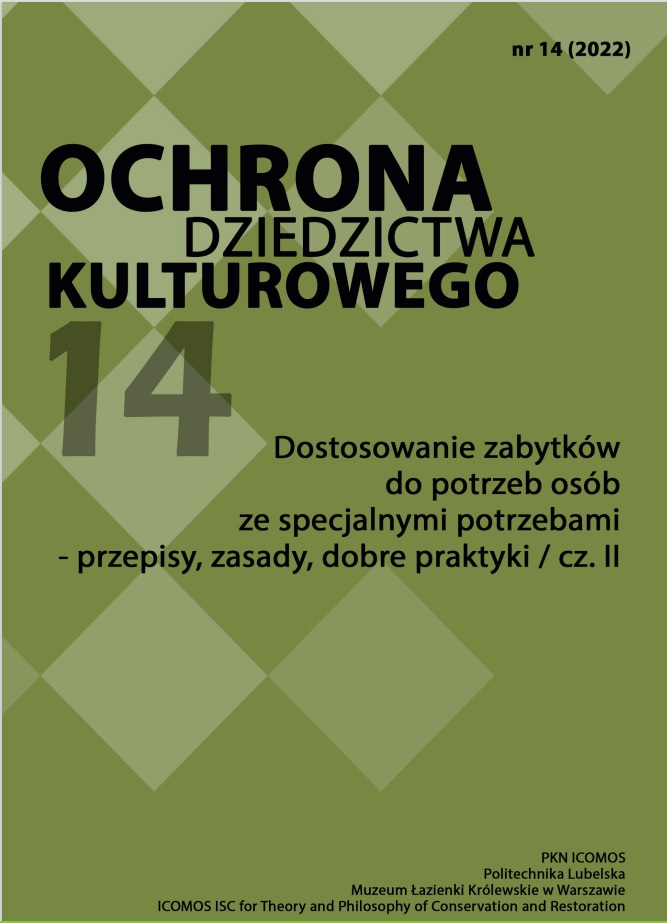Inkluzywne strategie projektowania dla muzeów. Cele i uwagi dotyczące szerszego dostępu do kultury
##plugins.themes.bootstrap3.article.sidebar##
Open full text
Numer Nr 14 (2022)
-
Poprawa dostępu do zabytkowych budynków: wybrane doświadczenia angielskie
Nigel Walter
-
Inkluzywne strategie projektowania dla muzeów. Cele i uwagi dotyczące szerszego dostępu do kultury
Sebastiano Marconcini
-
Międzynarodowe Karty Turystyki Kulturowej ICOMOS 1976-2021: Ewolucja, wkład i trendy w ochronie dziedzictwa kulturowego
Celia Martínez Yáñez
-
Wybrane aspekty zapewnienia dostępności obiektów zabytkowych dla osób z niepełnosprawnością ruchową
Barbara Rymsza, Krzysztof Kaperczak
-
Dobre praktyki udostępniania sztuki i kultury osobom niesłyszącym i niedosłyszącym na wystawie Deafland w Muzeum Śląskim w Katowicach
Agnieszka Kołodziejczak
-
Rozwiązania inkluzywne w terenach zieleni zabytkowej
Dorota Sikora
-
Ogrody zabytkowe – czy dla wszystkich?
Renata Stachańczyk
-
Dostosowanie Zamku Królewskiego na Wawelu do potrzeb osób z ograniczeniami ruchu
Rafał Jeżowski
##plugins.themes.bootstrap3.article.main##
DOI
Authors
sebastiano.marconcini@polimi.it
Abstrakt
Muzea są repozytoriami kultury, wiedzy i wartości, do których każdy powinien mieć dostęp. W tym celu należy zwrócić szczególną uwagę na kwestię niepełnosprawności podczas projektowania lub funkcjonowania takich obiektów. Pomimo zwiększonej świadomości wielu projektantów nadal nie rozumie w pełni złożoności potrzeb ludzi i tematu inkluzji. Poprzez ukazanie rozwoju ewoluującej koncepcji różnorodności i tego, jak projektowanie może zapewnić środowisko umożliwiające lub uniemożliwiające dostep do sztuki, niniejszy artykuł ma na celu wyznaczenie ram poznawczych, aby podjąć kwestię szerszych rozwiązań udostępniania w przestrzeniach muzealnych. W szczególności, niniejsza praca skupia się na kontekście europejskim, jego historycznych miastach i dziedzictwie kulturowym. Dlatego potrzeby inkluzji muszą być zrównoważone z potrzebami konserwacji, co dodaje dodatkową warstwę złożoności. Muzeum zostanie następnie przeanalizowane z perspektywy inkluzywnej, podkreślając kwestie, którymi należy się zająć i dostarczając kilku sugestii na temat dostępnych narzędzi, aby je przezwyciężyć i przyznać każdemu dostęp do kultury.
Słowa kluczowe:
Bibliografia
Accolla, A. (2009), Design for all. Il progetto per l’individuo reale, Milano: Franco Angeli
Burchardt, T. (2004), “Capabilities and disability: the capabilities framework and the social model of disability”, in Disability & Society, vol. 19, n. 7, pp. 735-751
Clifford, J. (1997), “Museums as contact zones”, in Clifford, J., Routes. Travel and Translation in the Late Twentieth Century, Cambridge: Harvard University Press
Commission for Architecture and the Built Environment (2006), The principles of inclusive design. (They include you), London: Commission for Architecture and the Built Environment
Commission for Architecture and the Built Environment (2008), Inclusion by design. Equality, diversity and the built environment, London: Commission for Architecture and the Built Environment
Del Zanna, G. (2005), Progettare l’accessibilità, Palermo: Grafill
European Institute for Design and Disability (2004), The EIDD Stockholm Declaration, Stockholm: European Institute for Design and Disability
Council of Europe (2005), Framework Convention on the Value of Cultural heritage for society (Faro Convention), CETS 199, Faro
International Council of Museums (2017), ICOM statues. As amended and adopted by the Extraordinary General Assembly on 9th June 2017, Paris: ICOM
Laurìa, A. (ed.) (2003), Persone reali e progettazione dell’ambiente costruito. L’accessibilità come risorse per la qualità ambientale, Dogana: Maggioli Editore
Laurìa, A. (ed.) (2012), I piani per l’accessibilità. Una sfida per promuovere l’autonomia dei cittadini e valorizzare i luoghi dell’abitare, Roma: Gangemi Editore
Marconcini, S. (2019), “Inclusion, identity and cultural heritage: A bond of reciprocity”, in Marconcini, S., Caramaschi, S., Marinaro, L. (eds.), Exploring Identities. Perspective from a a cross-disciplinary dialogue, QU3 - iQuaderni di U3, Macerata: Quodilibet
Mitra, S. (2006), “The capability Approach and Disability”, in Journal of Disability Policy Studies, vol. 16, n. 4, pp. 236-247
Norman, D. A. (2011), Living with complexity, Cambridge: The MIT Press
Null, R. (2013), Universal Design. Principles and Models, Boca Ranton: CRC Press
Sørmoen, S. (2016), “Accessibility to the message. An accessibility rethink”, in Arenghi, A., Garofolo, I. & Sørmoen, S. (eds.), Accessibility as a key enabling knowledge for enhancement of cultural heritage, Franco Angeli, Milano.
Steinfeld, E., Maisel J. L. (2012), Universal Design. Creating inclusive environments, Hoboken: John Wiley & Sons
United Nations (UN) 2006, Convention on the Rights of Persons with Disabilities, New York: United Nations
United Nations General Assembly (1948), Universal Declaration of Human Rights, Paris: United Nations
Witcomb, A. (2003), Re-Imagining the Museum. Beyond the Mausoleum, London: Routledge
World Health Organization (WHO) 2001, International Classification of Functioning, Disability and Health, Geneva: World Health Organization
##plugins.themes.bootstrap3.article.details##
Abstract views: 451
Licencja

Utwór dostępny jest na licencji Creative Commons Uznanie autorstwa – Na tych samych warunkach 4.0 Miedzynarodowe.






